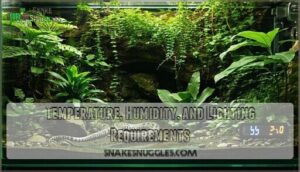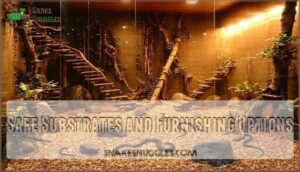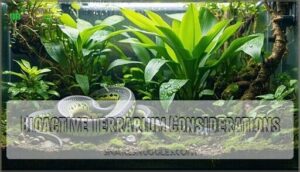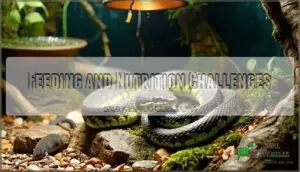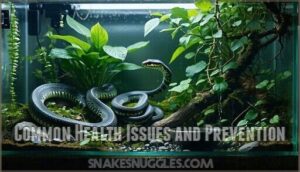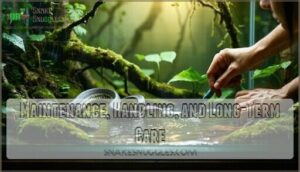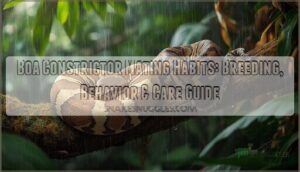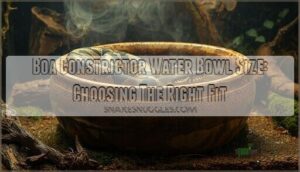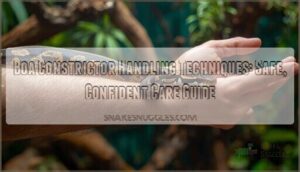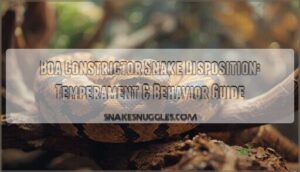This site is supported by our readers. We may earn a commission, at no cost to you, if you purchase through links.
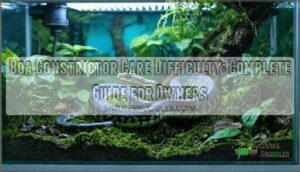 A thirty-pound snake that lives three decades isn’t what most people picture when they imagine a low-maintenance pet. Boa constrictors demand consistent environmental monitoring, space that grows with their muscular frames, and a willingness to source rabbit-sized prey for years to come.
A thirty-pound snake that lives three decades isn’t what most people picture when they imagine a low-maintenance pet. Boa constrictors demand consistent environmental monitoring, space that grows with their muscular frames, and a willingness to source rabbit-sized prey for years to come.
The care difficulty sits somewhere between a corn snake’s beginner-friendly routine and a reticulated python’s expert-level demands—you’ll need precision with temperature gradients, patience during decades of feeding schedules, and the physical confidence to manage a powerful constrictor.
Understanding these requirements before commitment separates successful keepers from overwhelmed owners scrambling to rehome a six-foot reptile.
Table Of Contents
Key Takeaways
- Boa constrictors require intermediate-level commitment spanning 20 to 40 years, demanding daily environmental monitoring, precision temperature gradients between 75–90°F, and enclosures scaling from 24 inches for juveniles to a minimum of 6 feet for adults weighing up to 30 pounds.
- Housing complexity exceeds beginner snakes like corn snakes due to specific humidity requirements (55–75%, spiking to 85% during sheds), semi-arboreal climbing needs, and substrate selection affecting respiratory health and thermoregulation efficiency.
- Feeding protocols shift from weekly meals for juveniles to biweekly schedules for adults, with prey sizing under 15% body weight and strict 48-hour no-handling periods preventing regurgitation syndrome that kills nearly 25% of neonates.
- Care difficulty sits between corn snakes’ beginner-friendly routines and reticulated pythons’ expert demands, requiring sustained expertise in thermal regulation, decades of sourcing rabbit-sized prey, and physical confidence managing powerful constrictors.
How Difficult is Boa Constrictor Care?
Caring for a boa constrictor sits somewhere between beginner and intermediate territory. You’ll need to stay on top of specific environmental conditions and think long-term.
Three main factors will show you whether you’re actually ready for this commitment.
We’ll walk through what makes boas more or less challenging, how they stack up against other popular pet snakes, and what kind of time you should expect to invest.
Key Factors Influencing Care Complexity
Whether keeping a boa constrictor feels manageable or overwhelming depends on a few critical factors—enclosure size, thermal regulation precision, and feeding protocol adherence top the list.
Your experience level with reptile care directly affects how you’ll navigate husbandry challenges, while the snake’s behavior and longevity factors—boas can live 30-plus years—demand sustained commitment to habitat design and boa constrictor health and care protocols.
Comparison With Other Pet Snakes
When you compare boa constrictor care to other pet snakes like corn snakes and ball pythons, you’ll immediately notice the demands scale up. Boas reach 6 to 10 feet compared to corn snakes’ 4 to 5 feet, requiring enclosures measuring 8’L × 4’W × 4’H—far exceeding the 30-gallon tanks suitable for corn snakes. Owner preferences often shift once they understand these distinctions in snake size comparison and pet snake costs:
- Adult boas weigh up to 30 pounds, dwarfing ball pythons’ 3-5 pounds and corn snakes’ 2 pounds
- Feeding adult boas requires sourcing rats or rabbits, costlier than mice for smaller species
- Handling techniques demand caution due to boas’ muscle power, unlike corn snakes’ gentler disposition
- Snake temperament varies: boas are docile but powerful, ball pythons ball up when stressed, corn snakes rarely bite
- Humidity precision for reptile care increases maintenance complexity compared to corn snakes’ forgiving requirements
Corn snakes remain the beginner-friendly standard for pet snake care, while boa constrictor and ball python husbandry requires more vigilance in environmental control and constrictor care protocols. Understanding proper snake care is essential for providing a healthy life for these animals.
Time and Commitment Required
Owning a boa means accepting a decades-long responsibility that dwarfs the weekly feeding routine or monthly deep cleans—you’re committing to 20 to 40 years of consistent care that demands more than just showing up.
Your owner dedication extends beyond boa constrictor husbandry basics to monitoring environmental parameters daily, tracking growth patterns, and scheduling annual veterinary visits.
This time investment in reptile care isn’t negotiable—boa constrictor environment stability requires vigilance, and lifetime responsibility means adjusting your life plans around snake care and maintenance needs for potentially four decades.
Essential Housing and Enclosure Needs
Creating a proper enclosure isn’t just about picking a big tank—it’s about replicating the environment your boa needs to thrive. The right setup depends on your snake’s age, size, and natural behaviors.
Here’s what you need to get housing right.
Minimum Enclosure Size for Juveniles and Adults
Your juvenile boa needs at least 24 inches of horizontal space to start, while adults demand a minimum of 6 feet in length—anything smaller restricts natural movement and can lead to stress-related health problems.
When planning your snake enclosure, consider these critical enclosure dimensions:
- Juvenile terrarium size: 24 inches long × 15-24 inches high
- Adult boa constrictor: 6 feet long × 2 feet wide × 2 feet high
- Enclosure setup with proper ventilation needs for air exchange
- Space requirements allowing room for temperature gradients
- Adequate height for semi-arboreal climbing behavior
Don’t house multiple boas together except during breeding attempts.
Temperature, Humidity, and Lighting Requirements
Temperature Control demands precision—your boa requires a thermal gradient spanning 75–90°F, with basking zones hitting 86–95°F while cooler areas drop to 68–72°F at night.
Humidity Management stays ideal between 55–75% relative humidity, spiking to 85% during shedding cycles.
Lighting Cycles follow a seasonal photoperiod: 13 hours light in summer, 11 in winter.
Environmental Monitoring tools—digital hygrometers and infrared temperature guns—verify your UVB lighting and thermal gradient settings prevent stress without constant guesswork. Maintaining the right humidity levels is vital for the overall health of your boa constrictor.
Safe Substrates and Furnishing Options
Substrate selection impacts your boa’s respiratory health, thermoregulation efficiency, and susceptibility to scale rot—factors that require matching material properties to species-specific behavioral patterns. Substrate materials like EcoEarth coconut fiber or Terra Firma Substrate Kit provide moisture retention without mold growth, while cypress mulch offers similar benefits.
For furnishing ideas, install climbing structures using secured branches positioned diagonally—boas exhibit semi-arboreal behavior even as adults. Snake hides placed at both thermal extremes reduce stress, and decorative rocks positioned under basking zones improve heat transfer while anchoring your setup before considering a bioactive boa constrictor enclosure.
Bioactive Terrarium Considerations
Bioactive systems introduce living decomposers—springtails, isopods, and beneficial bacteria—that process waste while stabilizing humidity, though they demand substrate depth exceeding 4 inches and careful species selection to prevent microfauna collapse under your boa’s weight.
Your terrarium design requires soil selection combining organic topsoil with drainage layers, while plant choices like pothos or snake plants tolerate crushing without introducing toxicity concerns.
Microfauna management depends on maintaining ecosystem balance through controlled feeding schedules that prevent protein overload—excess rodent remains overwhelm decomposer populations faster than they can establish colonies in your bioactive boa constrictor enclosure.
Feeding and Nutrition Challenges
Feeding boa constrictors properly requires understanding their changing nutritional needs throughout their lifespan. While the basic protocol—offering appropriately sized frozen-thawed prey—seems straightforward, several variables affect success rates and snake health.
Below, we’ll walk through the most important feeding practices you’ll want to get right as a boa owner.
Feeding Schedules by Age and Size
Your boa’s feeding schedule isn’t one-size-fits-all—it shifts dramatically as your snake matures from a hatchling into a full-grown adult. Juvenile boas require weekly meals to support rapid growth, while adults shift to feeding every one to two weeks.
This adjustment in feeding frequency reflects changing dietary needs and metabolic rates. Proper meal sizing and growth monitoring guarantee your snake receives adequate nutrition without overfeeding, which can lead to obesity and associated health complications.
Prey Types and Sourcing
Selecting the right prey species and establishing reliable sources can make or break your feeding routine—frozen-thawed rodents remain the benchmark for safety and convenience. You’ll feed hatchling boas mice, shifting to rats as they mature, with occasional rabbits for large adults.
Essential sourcing options include:
- Frozen rodents from specialized reptile suppliers eliminate injury risk from live prey
- Pre-killed prey items stored properly maintain prey nutrition for up to six months
- Reputable vendors guarantee consistent sizing and rodent diet quality for your boa constrictor diet and feeding needs
Preventing Feeding-related Health Issues
Regurgitation syndrome kills nearly a quarter of neonate boas during their first year—but you can sidestep this crisis with precise feeding techniques and consistent temperature control. Keep prey size under 15% of your snake’s body weight, maintain enclosure warmth between 82–F and 88–F, and avoid handling for 48 hours post-meal to cut regurgitation risk by over 40%. Balance feeding frequency with body condition monitoring to prevent obesity, which affects more than a third of captive boas and disrupts liver and cardiovascular function.
| Risk Factor | Impact on Boa Constrictor Health | Prevention Strategy |
|---|---|---|
| Oversized prey (>15% body weight) | 28% higher regurgitation risk | Match prey diameter to snake’s thickest body section |
| Handling stress within 48 hours | 65% increase in juvenile regurgitation events | Establish strict no-contact period after feeding your boa constrictor |
| Dehydration during digestion | 32% rise in regurgitation and constipation | Maintain 55-70% humidity and constant water access for digestive health |
| Overfeeding adults (<14-day intervals) | 38% increase in obesity complications | Adjust rodent diet schedule using body condition scores for nutrition planning and obesity management |
Monthly weigh-ins let you track deviations from healthy growth curves—adult boas usually weigh 3.5 to 7 kg with visible muscle definition along their flanks. Proper hydration aids kidney and liver function while promoting efficient nutrient absorption, making water availability as critical as feeding guidelines for long-term boa constrictor diet success and regurgitation prevention.
Handling After Feeding
Once you’ve locked down those feeding protocols, the hardest part becomes resisting the urge to pick up your snake. Post-meal handling triggers 65% of stress-induced regurgitation in juvenile boas and can flip a smooth digestion cycle into a veterinary emergency.
Wait 48 to 72 hours before resuming contact, allowing your boa constrictor’s digestive enzymes to break down prey without interference. This feeding restraint protects gastric function and keeps your snake’s stress hormones low during nutrient absorption.
Common Health Issues and Prevention
Your boa constrictor can develop health problems, but most are preventable when you maintain the right habitat conditions and stay alert to changes.
Catching warning signs early typically means quick, simple treatment instead of dealing with serious illness down the road.
Below, we’ll walk through the main health issues boa owners face and practical ways to keep them from happening.
Recognizing Inclusion Body Disease and Other Illnesses
Vigilance against inclusion body disease (IBD) and other health problems safeguards your boa’s longevity. Affecting up to 34% of captive boas, IBD is a fatal reptile virus with no cure, making early veterinary diagnostics critical for disease transmission control.
Watch for these warning signs:
- Intermittent regurgitation followed by loss of appetite
- Neurological symptoms like head tremors or disorientation
- Chronic weight loss and abnormal shedding patterns
Secondary medical problems—stomatitis, pneumonia, or vertebral infections—often accompany IBD. Request RT-PCR testing and blood smears during annual veterinary care to detect asymptomatic infections before introducing new snakes.
Signs of Improper Shedding and Skin Problems
Healthy shedding in boas involves one complete piece of skin that slides off like a sock, but retained eye caps, patchy sheds, or scale discoloration signal husbandry errors that you’ll want to correct immediately. Dysecdysis is usually caused by inadequate humidity—maintain 70% during the shedding cycle to prevent these health concerns.
Address skin problems promptly to prevent systemic infections.
| Problem | Primary Cause |
|---|---|
| Retained eye caps | Humidity below 60% |
| Patchy ecdysis | Dehydration or mite infestations |
| Scale rot | Excessive moisture with poor ventilation |
| Skin lesions | Bacterial or fungal infections |
Importance of Regular Veterinary Care
Annual veterinary checkups are your primary tool for detecting asymptomatic diseases. Studies show that 41.5% of tested boas carry inclusion body disease, yet 87% appear clinically healthy.
You’ll spend roughly $200 per year on routine health screenings, with basic exams ranging from $50 to $100. Reptile veterinarians assess skin integrity, muscle mass, and cloacal health while providing husbandry feedback based on your enclosure photos.
Pet insurance ($10–$20 monthly) offsets veterinary costs and aids disease prevention throughout your boa’s 20- to 30-year lifespan.
Parasite Prevention and Control
Internal parasites—nematodes, tapeworms, and protozoans—affect up to 60% of wild-caught boas, though captive-bred specimens show markedly lower infection rates when sourced from reputable breeders. You’ll need fecal examinations during veterinary checkups to detect intestinal parasites before clinical signs emerge. Deworming methods prescribed by your reptile veterinarian target specific parasites while preserving intestinal health.
Snake mites require immediate quarantine protocols and enclosure sterilization. Maintaining proper humidity prevents fungal infections, while isolation of new acquisitions reduces disease transmission risks, including inclusion body disease.
Maintenance, Handling, and Long-Term Care
Maintaining a boa constrictor extends well beyond the initial setup. Your responsibilities include regular cleaning schedules, proper handling techniques, and monitoring your snake’s long-term health as it ages.
Let’s walk through the maintenance tasks and care practices you’ll need to know for your boa’s decades-long life.
The following sections outline the specific maintenance tasks and care practices you’ll need to master throughout your boa’s decades-long lifespan.
Daily, Weekly, and Monthly Cleaning Routines
A consistent cleaning schedule isn’t just about hygiene—it’s your first line of defense against respiratory infections, scale rot, and parasitic infestations that can quickly compromise your boa’s health. Daily waste removal prevents bacterial proliferation in your reptile enclosure, while weekly substrate maintenance tackles soiled bedding in high-traffic areas.
Monthly deep cleaning with a diluted bleach solution eliminates pathogens without disrupting humidity control. For bioactive terrarium setups, adjust frequency based on cleanup crew efficiency while monitoring enclosure sanitation parameters.
Safe Handling Practices for Boas
Proper management technique starts with reading your boa’s body language. Approach when she’s alert but calm, not when she’s hidden, shedding, or within 48 hours of feeding.
Wash your hands first to remove food odors. Support her body in at least two places during gentle removal, using a snake hook for safety with larger specimens.
Don’t manage if she’s in defensive posture—coiled tightly with her head raised signals she needs space, not constrictor restraint.
Monitoring Growth and Weight
Tracking your boa’s weight and length every two weeks isn’t busywork—it’s your earliest warning system for metabolic disorders, parasitic loads, and feeding schedule adjustments that can mean the difference between a thriving snake and a veterinary emergency.
Maintain detailed feeding records and growth charts documenting:
- Scale measurements taken at consistent intervals
- Weight logs correlated with shed cycle patterns
- Body condition scores noting muscle tone changes
- Feeding response variations indicating health tracking needs
These health tracking benchmarks reveal subtle declines before clinical signs emerge.
Lifespan Expectations and Owner Commitment
Boa constrictor species commitment extends 20 to 30 years on average, with documented cases reaching 40 years—a timespan that outlasts most undergraduate degrees and first mortgages.
This reptile longevity demands multi-decade owner responsibilities, spanning housing upgrades as your boa reaches adult size, consistent reptile care protocols, and financial planning for veterinary expenses.
Long-term care isn’t negotiable; it’s the baseline for responsible boa constrictor care and species commitment to these complex animals.
When to Call a Vet
You don’t need to wait for catastrophe to strike—early intervention makes the difference between a routine appointment and emergency surgery. Schedule a veterinarian visit when you observe:
- Respiratory tract disease signs: wheezing, mucus discharge, or open-mouth breathing
- Inclusion body disease (IBD) indicators: loss of coordination, regurgitation, or abnormal posturing
- Snake mites, wounds, or persistent refusal to feed beyond normal fasting cycles
These vet visit signs warrant immediate professional assessment—reptile disease and prevention protocols depend on rapid response to snake injury and illness symptoms.
Frequently Asked Questions (FAQs)
Can boas be housed together safely long-term?
No—boas should be housed individually except during breeding attempts. Co-housing increases stress, competition for resources, and disease transmission risk.
While snake socialization isn’t necessary for boa constrictor care, proper boa constrictor housing with adequate snake enclosure requirements and appropriate snake management ensures long-term safety.
What are the costs of setting up initially?
Initial Investment for Boa Constrictor Habitat Setup ranges from $300 to $800.
Equipment Expenses include enclosures, reptile lighting and heating systems, and substrates. Setup Costs also cover hides, water bowls, and thermometers.
Food Budget and Veterinary Fees add ongoing expenses.
How do you handle escaped or aggressive boas?
Escaping the proverbial garden can turn deadly fast. For Snake Escape Prevention, secure your enclosure with locks and inspect seals weekly. If your boa escapes, search warm, dark spaces methodically.
Recognize Aggression Signs like hissing or striking—never grab an aggressive boa bare-handed. Use proper Boa Restraint with a Snake Hook Safety technique, supporting the body’s weight during snake management.
In an Emergency Response, stay calm, control the head gently, and never punish your boa constrictor. These Management Tips and Safety with Snakes protocols protect both handler and animal.
Do boas need UVB lighting in their enclosure?
UVB lighting remains debated among herpetologists, though boas don’t strictly require it since they’re crepuscular and obtain vitamin D3 from whole prey. However, low-level UV exposure may support natural behaviors and calcium metabolism.
If you skip UVB, verify your thermal gradient includes appropriate heat sources and maintain proper enclosure lighting for day-night cycles.
What permits or licenses are required for ownership?
Permit requirements vary considerably by jurisdiction, so check your local and state ownership laws before acquiring a Boa Constrictor.
Most states don’t require exotic permits for boas, but some impose restrictions or license fees for reptile care and regulatory compliance.
Conclusion
Your first feeding mishap won’t define your success—decades of consistent environmental precision will.
Boa constrictor care difficulty level ultimately reflects your commitment to monitoring temperature gradients within two-degree margins, sourcing appropriately sized prey through three growth phases, and maintaining manipulation confidence as your six-foot companion reaches adult power.
The species forgives occasional scheduling lapses better than environmental negligence, rewarding careful keepers with thirty years of predictable behavior and manageable health needs.
- https://animals.howstuffworks.com/snakes/boa-constrictor.htm
- https://www.petmd.com/reptile/boa-constrictor-care-sheet
- https://reptilesmagazine.com/care-and-breeding-of-true-red-tailed-boas-in-captivity/
- https://reptifiles.com/boa-constrictor-care/boa-constrictor-enclosure-size/
- https://www.thebiodude.com/blogs/snake-caresheets/boa-constrictor-care-guide-and-bioactive-terrarium-maintenance


